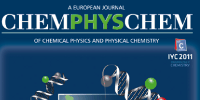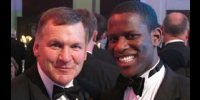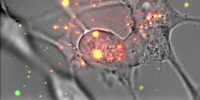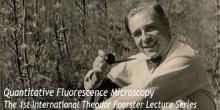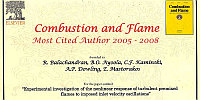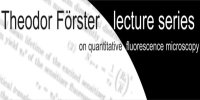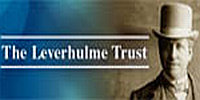A selection of our group's news prior to 2013.
| February 2011 |
Theodor Förster 100th Anniversary Issue published by ChemPhysChem
|
A special issue in memory of Theodor Förster was published by ChemPhysChem, edited by Clemens Kaminski, Erich Sackmann, and Klaus Schulten. Förster would have been 100 this year and the issue is in celebration of his outstanding achievements in photophysics and photochemistry, featuring reviews and research articles by world leading scientists in the field. More than 60 years ago Förster formalized the theory of non radiative energy transfer, today known as Förster resonance energy transfer (FRET), a process that is ubiquitous in nature. Today FRET is revolutionising modern biology offering one of the most powerful methods by which information on biomolecular structure and interactions can be gained from living biological systems. Link to Chem Phys Chem |
| October 2010 |
IChemE Awards
|
The IChemE awards recognise and reward chemical engineering innovation and excellence. Now in their 17th year, they celebrate both individual and team achievement. Ssegawa-Ssekintu Kiwanuka of the Laser Analytics group was the youngest ever nominee in the history of the awards at 23, and gained 3rd place in the young engineer of the year category. The award recognises individuals under the age of 30 who demonstrate achievements and tangible application of chemical, biochemical and/or process engineering skills to address important economic, environmental or social issues. Department News |
| February 2011 |
Cambridge Advanced Imaging Centre
|
Prof. Bill Harris (PDN), Dr. Richard Adams (PDN), Dr. C. Kaminski, Prof. D. Klenermann (Chemistry) and J. Skepper (PDN) have together won financial support from the Wolfson Foundation to initiate the Cambridge Advanced Imaging Centre (CAIC) at the University of Cambridge.
|
| November 2009 |
GBP 5M award for Alzheimer's disease research
|
The Laser Analytics Group is part of a major research initiative led by Prof. St George-Hyslop from the Cambridge Institute for Medical Research to investigate the molecular mechanisms leading to Alzheimer's, a debilitating and lethal disease, affecting more than 450000 people in the UK alone. The initiative was recognised by the award of a 5 year Wellcome Trust / MRC strategic award worth more than GBP 5M. At the heart of Alzheimer's and other neurodegenerative diseases lies the dysfunction of normally harmless proteins occurring naturally in the brain so that they form toxic aggregates, which cause cells to malfunction and ultimately die. The laser group has developed a novel microscopy method which will play an important role in this research because it allows for the first time the formation of such toxic aggregates to be measured in living species. The research will be conducted in strong collaboration with groups across the university of Cambridge and involve chemists, physicists, engineers, medics and biologists. Press Release |
| December 2009 |
Launch of new website for CamBridgeSens |
The web site of CamBridgeSens operated and managed by members of the Laser Analytics Group has been extensively redesigned to provide better access to, and easier navigation within, the available information on the pages and to cater for the rapid expansion that the CamBridgeSens network is currently experiencing. In the only 16 months since its inception, the network has grown its membership to over 380 researchers from more than 10 university departments. More than 50 members represent participation of local and national companies, keen to strengthen ties with the University of Cambridge. |
| January 2009 |
Special Journal Issue on Quantitative Fluorescence Microscopy
|
A themed issue on quantitative fluorescence microscopy is published in February by the Royal Society Interface Journal. The issue is dedicated in its entirety to the first International Theodor Foerster lecture series organised by the Laser Analytics group and features review and original articles by some of the world's foremost microscopists. All articles are free to download and more information is found under: Quantitative Fluorescence Microscopy Issue |
| January 2009 |
Most Cited Paper in Combustion and Flame
|
The Laser Analytics group won the most cited Author 2005-2008 award for the paper entitled "Experimental Investigation of the nonlinear response of turbulent premixed flames to imposed inlet velocity fluctuation", Comb. Flame, Vol 143, Issue 1-2 (2005), Pages 37-55. The work is a collaborative effort within the University gas partnership and was co-authored with the groups of Prof. Ann Dowling and Dr. A. Mastorakos at the department of Engineering, Cambridge. The full paper can be downloaded from: Nonlinear Flame Response paper |
| October 2008 | CamBridgeSens workshop Recent Trends in Optical Trace Sensing |
The workshop focuses on recent advances in optical trace sensing. This event will bring together academics and students of Cambridge to discuss the latest developments in gas and liguid phase sensing. We have the pleasure to hear talks from four invited speakers covering topics such as expanding the wavelength coverage of supercontinuum light sources, spectral broadband sensing in the gas and liquid phase using lasers, LEDs and supercontinuum sources. The workshop is hosted by the Laser Analytics Group and will be arranged in Emmanuel College, Cambridge, on 11th November 2008. For more details and booking see: CamBridgeSens |
| November 2008 |
Our research featured in Nature Photonics Research Highlights
|
Recent research from the Laser Analytics Group featured in the Research Highlights section of the September issue of Nature Photonics. In a collaboration with the Atmospheric Sensing group of the Department of Chemistry in Cambridge we have developed a broadband trace gas detection scheme based on cavity enhanced absorption spectroscopy (CEAS) and a supercontinuum (SC) light source. It is capable of recording spectra covering over 100 nm in the visible spectral range, encompassing multiple absorption bands of NO2, NO3, H2O, O2 and O2-O2 (oxygen dimer). For NO3, a detection limit of 3 parts per trillion (ppt) was achieved in measurement interval of only 2s. SC-CEAS is easy to implement, robust and precise and ideally suited for multiplexed detection of several species at once. For more details see: Nature Photonics Research Highlight |
| July 2008 | 3rd Koerber meeting hosted by Laser Analytics Group
|
The Koerber project on the use of photonic crystal fibres in biomedicine and sensing is a cross-disciplinary collaboration between research teams at the Universities of Bath, Cambridge, Edinburgh, Erlangen, Warwick and Queen Mary University of London. Its goals are to explore the application of photonic crystal fibres in compact super-bright broadband light sources for microscopy, ultra-high sensitivity environmental (water & air) monitoring, and medical applications such as flow cytometry and metabolite sensing. The 3rd project meeting is hosted by the Laser Analytics Group in Cambridge from Oct. 3-5 2008 |
| July 2008 | CamBridgeSens - bridging the gaps in sensor research
|
Dr. Mica Green has been appointed as project co-ordinator for CamBridgeSens, a large scale network activity across the University of Cambridge to connect sensor related science across departments in Cambridge. The project is funded by EPSRC and headed by Dr. C. Kaminski and Prof. Lisa Hall to promote an innovative multidisciplinary research culture in Cambridge for sensor research. More information is found in issue 6, 2008 of the University Horizon magazine: News Feature. The project's web site is at: onwww.sensors.cam.ac.uk |
| October 2007 |
Theodor Foerster Lecture Series
|
The Laser Analytics Group hosts the 1st Theodor Förster International Lecture series at the University of Cambridge comprising lectures by some of the world's most eminent scientists in biological fluorescence imaging. The emphasis of the series is the quantitative application of state-of-the-art optical methods to solve problems in the life sciences. The series is associated with the Physics of Living Matter initiative in Cambridge. The lecture series is generously sponsored by leading industries developing microscopy instrumentation and the main events will be accompanied by journal clubs, practical demonstrations, and displays of the latest technologies. |
| January 2008 |
100000 Euro research prize for Clemens Kaminski
|
Clemens Kaminski is recipient of the prestigious SAOT research prize, awarded by the School of Advanced Optical Technologies at the University of Erlangen / Nuremberg in Germany. The prize is in recognition for his contributions in Applied Optics research and is worth 100000 Euros. In conjunction with the prize, Kaminski was appointed as Guest Professor at the SAOT school, which he holds in the newly founded Max Planck Institute for the Physics of Light, Erlangen in the group of Professor Philip Russell. Further links: |
| March 2007 | Green Sensors
|
The work of Dr Johan Hult on sensor design has been featured in the Newsline magazine of the EPSRC. Dr Hult has also given an invited talk on his research at the recent Horizons Event organised by the University of Cambridge. |
| September 2007 | FLAIR 2007
|
The 1st international conference on Field Laser Applications in Industry and Research took place in Florence and was attended by Iain Burns, Toni Laurila and Clemens Kaminski, who all gave talks. Kaminski also served in the organisation of the meeting as a founding member of the programme committee. Full details on the Department News Page and on the conference website |
| September 2006 | Photon06
|
Members of the group attended the Photon06 conference in Manchester and gave several oral presentations. This is the largest UK conference for optics and photonics research. Full details on the Department News Page |
| January 2007 | Leverhulme Visiting Professor
|
Professor Houston Miller from George Washington University is hosted by the Laser Analytics group. Professor Miller will collaborate with us to establish technologies for probing biomolecules using gold nanoparticle enhanced SERS (surface enhanced Raman spectroscopy). He furthermore will present a series of Leverhulme lectures to transfer knowledge in advanced optical diagnostic techniques. |
| November 2005 |
Leverhulme Prize
|
Dr Clemens Kaminski has been awarded the 2005 Philip Leverhulme Prize for outstanding research achievement in the development of fast chemical imaging techniques. The prize is over GBP50k and to be used to follow personal research interests. Full details on the andDepartment News Page and University press release .
|
| February 2006 | LACSEA Conference
|
Dr. Johan Hult, Alan Elder, and Dr. C.F. Kaminski of the Laser Analytics Group attended the 10th international conference on Laser Applications in Chemical and Environmental Analysis, which took place at Incline Village, Lake Tahoe, Nevada, on Feb 5-10, 2006. Full details on the Department News Page. |
| October 2005 | Hinshelwood Prize
|
Dr Clemens Kaminski has won the 2004 Cyril Hinshelwood prize. The award is named after Cyril Hinshelwood who, together with Nikolay Semenov, received the 1956 Nobel prize in Chemistry for research into radical chain reactions. The Hinshelwood prize is awarded by the British Section of the Combustion Institute for outstanding work by a younger researcher in combustion science. Dr Kaminski received it for the development of laser based imaging techniques and their application to both fundamental and practical problems in combustion. |
| September 2005 | Gaydon Award
|
Members of the Laser Analytics Group have been awarded the Gaydon Award for the most significant UK contribution to the 30th International Symposium on Combustion, held in Chicago in 2004. The Symposium is the largest and most prestigious conference in the field and the prize went to Sara Gashi, Johan Hult, Karl Jenkins (Cranfield University), Nilan Chakraborty (Dept. of Engineering, Cambridge), Stewart Cant (Dept. of Engineering, Cambridge), and Clemens Kaminski for their paper entitled: Curvature and wrinkling of premixed flame kernels - comparisons of OH planar laser induced fluorescence data and direct numerical simulations, Proceedings of the Combustion Institute, vol. 30 (2005) 809-817. The prize was awarded by the Combustion Institute (British Section) at the autumn meeting in Cambridge, on the 12th of September 2005. |

